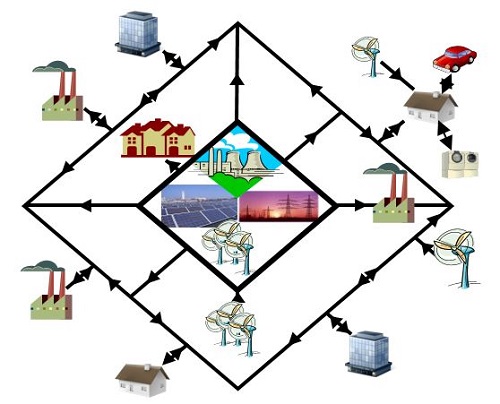
“Efficient Utilization of Electric Power” refers to the optimization of energy consumption from traditional power plants such as those fueled by coal, oil, and natural gas. Power consumption can be minimized by reducing sources of loss due to technical inefficiency and reducing the amount of waste arising from human activity. The research is in order to save energy and reduce the demand from conventional power sources such as coal. It is integrated intelligent electronic devices that can automatically control power flow by turning devices off or placing them in standby during periods of inactivity to reduce energy consumption. It can also support storage of excess power generation in storage elements like batteries to improve power quality and make it available to the grid for periods of high demand. More Renewable Energy from alternative sources can be incorporated into our grid networks and they are leading a revolution of power grid sturcture.
High penetration of small-scale distributed renewable energy resources (DER) is now connected to low voltage (LV) distribution ac networks. However, the intermittent nature of renewable energy sources conveys many challenges to the power quality (PQ) of the utility grid. Voltage variation in the network is a critical issue that causes system shutdown, loss of data, high losses, overheating of equipment and reduced lifetime. A transformerless unified power quality conditioner (TL-UPQC) is a good solution for tackling the PQ issues. RIGA Lab are developing technologies to solve all PQ issue in a single power converter. It would provide stable load voltage, grid voltage and sinusoidal grid current.
Suggested Reading - R. Abdalaal, and C. Ho, “System Modeling and Stability Analysis of Single-Phase Transformerless UPQC Integrated Input Grid Voltage Regulation”, IEEE Journal of Emerging and Selected Topics in Industrial Electronics, vol. 3, no. 3, pp. 670-682, July 2022. (PDF)
According to International Energy Agency, over 3 billion people are living in energy poverty and more than 1 billion people are living with no access to electricity. It has been a challenge to develop new ways to power up these unelectrified areas. The high cost and geographical limitations in most of unelectrified areas make the conventional power system, which relies on central generation and long-distance transmission, no longer effective to solve the current energy poverty problem. Meanwhile, to power up billions of people with conventional fuel-burn plants could generate giga tons more of carbon emission. Alternatively, Photovoltaic (PV) based off-grid dc microgrid systems have been developed with new business models to make electricity affordable to households in energy poverty areas. RIGA Lab are developing technologies forming a module-based Plug-n-Play DC Microgrid (MG). The MG has a bottom-up building feature that allows system growing organically as the demands growing. The feature that combines advantages of conventional Solar Home System and central MG could significantly reduce the difficulty of developing MGs in rural developing areas.
Suggested Reading - D. Li, and C. Ho, “A Module-Based Plug-n-Play Dc Microgrid with Fully Decentralized Control for IEEE Empower a Billion Lives Competition”, IEEE Trans. on Power Electronics, vol. 36, no. 2, pp. 1764-1776, Feb. 2021. (PDF)
The development of Smart Grid brings a technological revolution from the traditional centralized ac power network. In terms of technological development, the applications of renewable energy and battery energy storage elements have become more mature, and more and more appliances are changed to dc power. Therefore, the development of dc microgrids (MG) becomes the trend in future energy systems. the system protection is a key concern in dc MG, as it is related to the safety and stability of the whole system. Especially in the application of low-voltage (LV) public power grids, for any power generation system and solar power system fed in parallel to the grid, automatic disconnection equipment must be installed. RIGA Lab are developing technologies to realize a high-reliability hybrid circuit breaker solution to achieve both galvanic isolation and high-efficiency features. It is aimed at LV dc MG applications and provides with low conduction loss, low device electrical stress, bidirectional current flow, and double line physical isolation feature on the entire system.
Suggested Reading - K. Siu, C. Ho, and D. Li, “Design and Analysis of a Bidirectional Hybrid Dc Circuit Breaker using Ac Relays with Long Life Time”, IEEE Trans. on Power Electronics, vol. 36, no. 3, pp. 2889-2900, March 2021, (PDF)